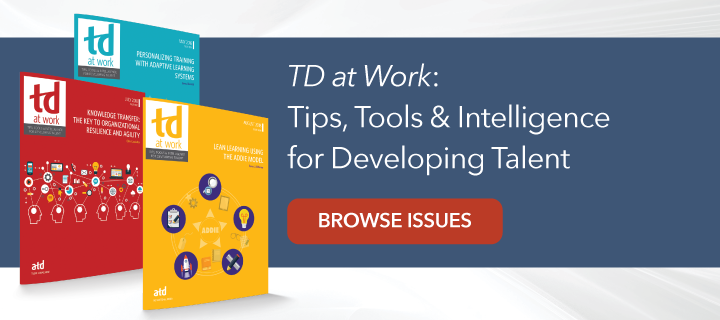Welcome new employees and quickly get them up to speed.
By now, many of us have become used to Zoom meetings with our managers or colleagues, having quick online chats about a work project, or reaching out via email to someone in a different department than ours with a question because that person has all the right inside knowledge. But if you joined your company during the pandemic and have worked mostly virtually for the past year, would you feel comfortable doing this?
In “Onboard New Hires Virtually,” Sharlyn Lauby walks learning and development professionals through designing or revising a virtual onboarding program using the ADDIE model. While she uses the analyze, design, develop, implement, and evaluate steps, she encourages readers to use whatever instructional design model they’re comfortable with.
Getting Started
In-person, virtual, onboarding, a training session—it doesn’t matter. You need to start the program by determining:- What are your organizational needs?
- What are your performance needs?
- What are your learning needs?
- What do learners need?
To find out the answers to these questions, you can use surveys, questionnaires, focus groups, or other methods. Senior managers, operational managers, HR, and current and past employees can help you obtain the information you need.
When designing the virtual onboarding program, you might consider using the A-B-C-D method for writing program objectives:
- Audience: Who will be taking part in the program?
- Behavior: What is the outcome of taking part in the program?
- Condition: Will there be any assistance provided during the program, such as a buddy or a manual?
- Degree: What level of competency are you looking for as a result of the program?
Virtual Components
Now that you have your program objectives, how will you reach your audience to change their behavior? What tools will you provide? And how will you do so in the virtual space?Consider these formats, which can instruct on aspects of onboarding that were formerly often done in person.
Videos. Gone are the days when you needed high-priced video equipment to produce training videos. Smartphones—as long as you have quality sound—can go a long way with your virtual onboarding needs. You can provide a virtual tour of headquarters, for example. Videos can be used to welcome new hires via messaging from the CEO, manager, HR, or the new hire’s team. They can also instruct on how to fill out necessary paperwork or to access necessary computer files.
Self-learning. Lauby explains that self-learning can run the gamut from assessments to reading assignments. “Send electronic copies of the information for new hires to access. As an added benefit, they will be able to access those virtual guides anytime they need to,” she writes.
Assessments, meanwhile, can help provide the new employee and their manager with career goals for the recent hire. As a result of the assessment, new hires may be assigned a webinar to watch, book to read, or podcast to listen to.
Collaborative activities. A new hire can get to know their team by working with them via an online meeting. Alternatively, the collaboration can occur with other new hires via a fun activity. Consider a scavenger hunt, finding company information on the intranet, or learning more about competitors by locating information on their website. Even though this fun activity has a game element, it should still tie to the program’s learning objectives.
Virtual tools. While Zoom fatigue is real, do connect the new hire with other faces. In addition to their manager, the new hire may meet and interact with a virtual buddy. Another activity may be for the new hire to “interview” a teammate to get to know how they’ll work together and add an element of organizational culture to the new employee’s understanding.
Implementing and Evaluating
As you develop your virtual onboarding program—or aspects of a program if you’re revising a current program; not all the program needs to be remodeled and unveiled at once—consider piloting the virtual program with individuals who have recently gone through in-person onboarding. They’ll have a perspective of where the onboarding program has improved or perhaps needs improving.Seek feedback as you carry out your new virtual program, checking in with new hires to gauge whether they have the information they need to be successful. Do they feel comfortable reaching out to colleagues whom they may never have met? Can they use the technology they have at hand to collaborate with teammates and have check-ins with their manager?
Recent research shows that many organizations will continue to be virtual or hybrid even after it’s “safe” to return to the office. Will you have a program in place that’ll allow new hires to effectively and efficiently get up to speed?




